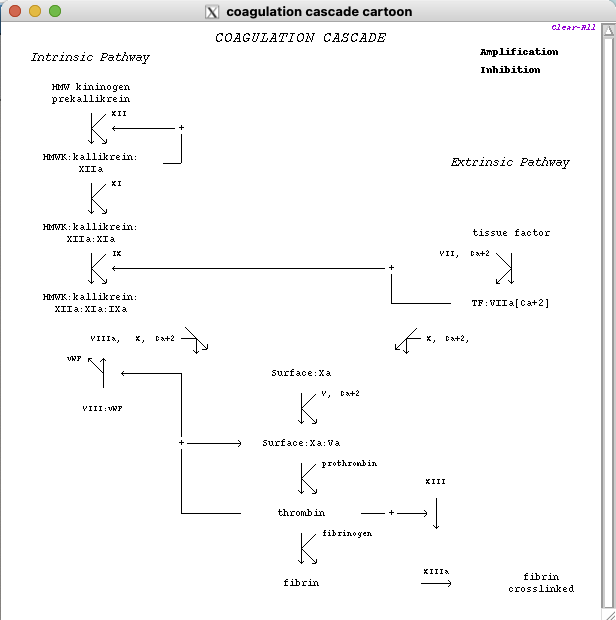Figure B: coagulation cascade (amplification)
Introduction
The arrest of bleeding depends upon primary platelet plug formation in conjunction with the elaboration of a stable fibrin clot. In the interim, vasoconstriction reduces blood flow through injured vessels. Formation of the fibrin clot involves the sequential interaction of a series of plasma proteins in an ordered fashion, as well as interactions of these proteins with platelets & with materials released from tissues.
The coagulation cascade is a process of signal amplification subject to inhibitory constraints. Specific extravascular membrane proteins* serve as receptors for zymogens & cofactors involved in coagulation. This triggers a cascade of events leading to the formation & cross-linking of fibrin. In the absence of a sufficient quantity of initiating factors, inhibitory mechanisms predominate & coagulation is suppressed.
The coagulation cascade is initiated when endothelium is injured, resulting in exposure of tissue factor (TF) constitutively expressed on the cell surface of subendothelial cells such as smooth muscle cells & fibroblasts. TF complexes with circulating coagulation factor VII resulting in an activated TF/VIIa complex (see extrinsic pathway).
Propagation occurs from TF/VIIa - catalyzed activation of factor IX & the intrinsic pathway. Thrombin also contributes to propagation. Coagulation centers around formation of thrombin. When small amounts of thrombin are formed, or when thrombin is diluted by a fast flowing circulation, thrombin acts as a platelet agonist initiating & enhancing platelet aggregation through the action of thrombin receptors on the surface of platelets. However, in static zones of flow (presumably secondary to prior platelet aggregation), thrombin will accumulate & convert fibrinogen into fibrin in the surrounding blood.
Thus, the interrelationships between platelet function (activation, adhesion & aggregation) & coagulation (clotting) are complex, & it is not possible to conceive of one without the other.
References
- ↑ Clinical Diagnosis & Management by Laboratory Methods, 19th edition, J.B. Henry (ed), W.B. Saunders Co., Philadelphia, PA. 1996, pg 719
